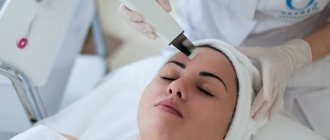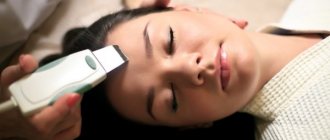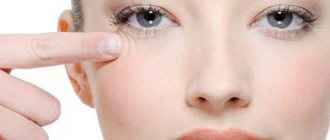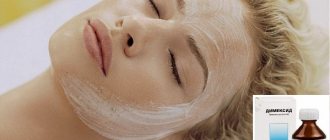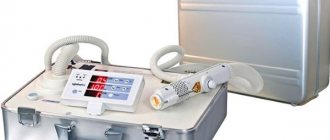Ultrasound has been successfully used in medicine, rehabilitation and diagnostics for more than 50 years. Recently, it has also found wide application in the rapidly developing and relatively new field of science - cosmetology. Ultrasound therapy stabilizes skin functions and regulates metabolism in its cells, helping to get rid of many problems: age-related changes, acne, scars, cellulite and others.
What is ultrasound?
Ultrasound is mechanical waves whose frequency exceeds the audibility limits of the human ear. This is a sound at such a high frequency that a person cannot even hear it. Ultrasonic waves with a frequency of 22-30 kHz, 1 MHz and 3 MHz are used in cosmetics and dermatology. A 1 MHz wave penetrates deep layers of tissue (up to 60 mm), 3 MHz works shallowly, superficially. The best penetration is obtained at low frequencies.
The discovery and use of ultrasound for medicinal and cosmetic purposes dates back to the end of the nineteenth century. In 1927, P. Langevin began research into the effect of ultrasound on living organisms. However, only in 1951, thanks to the work of R. Polman, ultrasound began to be used in medicine and technology. The first diagnostic ultrasound devices were created.
Currently, it is used in rehabilitation, surgery, rheumatology, dermatology, dentistry and cosmetology. In medicine, ultrasound is used to diagnose and treat, for example, diseases of the spine, bone fractures, scars and rheumatic diseases. Frequencies often used are 800 and 2400 kHz. In cosmetology, it serves to improve the condition of the skin and get rid of many of its shortcomings.
Is there a recovery period?
The procedure is very comfortable and does not cause pain and does not require anesthesia. Exfoliation gels based on natural ingredients give a feeling of freshness and high-quality skin care. And photosensitizers rich in antioxidants give the skin a radiant and healthy appearance.
The procedure itself is very comfortable and well tolerated by patients, and the reviews on it are always brilliant if a professional works!
We are waiting for you at our center. You can consult or sign up for a procedure with our cosmetologist Lola Sabirovna Babaeva by phone. Waiting for you!
How does ultrasound work?
During ultrasound therapy on the human body in tissues, you can observe:
- Mechanical action.
- Thermal effect.
- Physico-chemical action.
- Biological action.
The mechanical effect of ultrasound on the body, otherwise known as micromassage, consists of introducing molecules of therapeutic drugs into tissues with rhythmic vibrations. During exposure to sound waves, a pressure difference occurs, due to which the permeability of cell membranes increases, cellular metabolism accelerates and microcirculation improves. Body tissues are better supplied with nutrients and oxygen.
The thermal effect of ultrasound is that the energy transferred to tissues is converted into heat. This accelerates cellular metabolism and stimulates the production of hyaluronic acid, elastin and collagen.
The physicochemical effect of ultrasound manifests itself in accelerating metabolism in the skin. Protein breakdown accelerates, electrical conductivity in cells and tissues increases. The PH of the skin surface and the absorption of nutrients improves.
The biological effect of ultrasound is manifested in the following: it provides an analgesic effect, dilates blood vessels, and inhibits the nervous system.
Action and effect of the procedure
Ultrasound therapy is safe and can be used even on sensitive skin prone to irritation. During the procedure, a special gel is applied to the treated area. It is thanks to him that the ultrasonic wave penetrates deep into the skin without interruption.
Ultrasonic action
Ultrasound is currently used in cosmetology in procedures such as cavitation peeling and sonophoresis. Cavitation peeling is used to enhance skin regeneration and care. Thanks to its pleasant vibrations, it acts delicately on the facial skin and deeply cleanses it. The skin after it becomes fresh, clean and renewed. Sonophoresis significantly improves the penetration of beneficial active substances of cosmetic preparations into the deep layers of the skin.
Weaknesses that can be corrected
Ultrasound can cope with many deficiencies, such as:
- Matte skin.
- Pore blockage .
- Swelling of the facial skin, especially around the eyes.
- Peeling of the upper layer of the epidermis.
- Strong fat content .
- Improper functioning of the sebaceous glands.
- Pigmentation.
- Presence of unwanted hairs .
- Acne . _
After the procedure, the skin begins to breathe, becomes smoother, and returns to its normal color.
Indications for the use of ultrasound
Ultrasound therapy in cosmetology is used to solve various skin problems, including:
- Wrinkles and age-related skin changes.
- Acne.
- Rosacea.
- Cellulite.
- Scars and scars.
- Depilation.
- Hyperpigmentation.
However, one of the most common indications for the use of ultrasound is acne.
Type of ultrasound wave depending on the problem
Ultrasound therapy as a way to treat acne
Regular cavitation peeling accelerates skin renewal processes and alleviates acne symptoms. During the procedure, not only excess sebum is removed, but also bacteria, cosmetic residues and dead cells. Treatment requires a series of 7-10 sessions with breaks between them of 10-14 days. It all depends on the degree of the disease. Subsequently, as a preventive measure and to consolidate the effect, it is recommended to carry out the procedure once a month.
Ultrasonic facial cleansing
During cavitation peeling, it is also possible to perform sonophoresis or phonophoresis, during which active substances or medications are introduced into the deeper layers of the skin. Cavitation peeling gives the following effects:
- Removes acne.
- Reduces the severity of age spots.
- Tightens pores.
- Treats seborrhea.
- Reduces acne scars.
Regarding rosacea, ultrasound therapy should be performed at a frequency of 22-28 kHz or a frequency of 1 MHz every two or three days. It is suggested to use, for example, vitamin C or PP, arnica extract, drugs with metronidazole.
Reduction of pigmentation
Ultrasound is excellent in combating increased skin pigmentation. The preparation and treatment program is selected individually. The best lightening effects are achieved when the procedure is carried out once a week and using 2-5% trichloroacetic acid, ascorbic or lactic acid. Thanks to the influence of ultrasonic waves, microcirculation improves and fat cells are broken down.
Swelling and bruising around the eyes
Ultrasound facial treatment is perfect for those who suffer from swelling and bruising around the eyes. The main reason for their appearance is circulatory and metabolic disorders, which leads to the deposition of water and fat in the tissues around the eyes. Exposure to ultrasonic waves significantly improves blood circulation and metabolism, stimulates the skin's production of elastin and collagen. Thanks to this, swelling subsides and bruises become less pronounced.
Wrinkle smoothing and rejuvenation
Ultrasound is a great way to get rid of wrinkles. It increases hydration, improves skin elasticity and firmness. For rejuvenation, cavitation peeling and intense micromassage with ultrasound are performed. This massage promotes the penetration of active drugs into the skin, which contributes to the appearance of a lifting effect.
Ultrasound for rejuvenation
The procedure can be successfully combined with microdermabrasion and mesotherapy with hyaluronic acid and vitamins. Thanks to this, the skin will be even better hydrated, and its regeneration will noticeably improve.
Ultrasounds against cellulite
In recent years, high frequency ultrasound therapy has been frequently used to combat cellulite and reduce excess fat. Focused ultrasound waves speed up metabolism, destroy fat cells and promote their removal from the body. The skin surface becomes smoother and the figure more toned.
How does ultrasound affect fat deposits?
To obtain the expected results, treatment should be carried out regularly over a long period - at least 12 procedures. Usually the effect begins to appear by the 6th session. This largely depends on your skin type and the severity of the disease. However, after each procedure, the circumference of the hips, buttocks and thighs is noticeably reduced.
Depilation
Ultrasound is also used for hair removal. It is used in combination with a complex of biologically active substances. Thanks to the influence of ultrasonic waves, they better penetrate the hair follicles and cause destruction of the hair roots. The desired results are achieved after a series of sessions. After each procedure, the hair grows weaker, thinner and softer.
At the same time, ultrasound is also used to make hair thicker and accelerate its growth. It all depends on what drugs are used during the procedure.
Price
Focused UVT
| Focused extracorporeal shock wave therapy (1 anatomical zone - up to 3,000 shocks) | RUB 5,875 |
| Focused extracorporeal shock wave therapy (1 anatomical zone - up to 2,000 shocks) | RUB 5,011 |
| Focused extracorporeal shock wave therapy (1 anatomical zone - up to 4000 shocks) | RUR 6,394 |
| Focused extracorporeal shock wave therapy (2 anatomical zones - up to 4,000 shocks) - up to 30 min | RUB 7,430 |
| Focused extracorporeal shock wave therapy (2 anatomical zones - up to 6,000 shocks) - up to 30 min | RUB 8,467 |
| Focused extracorporeal shock wave therapy (2 anatomical zones - up to 8,000 shocks) - up to 30 min | RUB 10,195 |
Radial UVT
| Radial shock wave therapy (1 anatomical zone – up to 3,000 shocks) | 3 802,00 |
| Radial shock wave therapy (1 anatomical zone – up to 2,000 shocks) | 3 283,00 |
| Radial shock wave therapy (1 anatomical zone – up to 4,000 shocks) | 4 320,00 |
| Radial shock wave therapy (2 anatomical zones - up to 4,000 shocks) - up to 30 min | 5 530,00 |
| Radial shock wave therapy (2 anatomical zones – up to 6,000 shocks) – up to 30 min | 6 221,00 |
| Radial shock wave therapy (2 anatomical zones – up to 8,000 shocks) – up to 30 min | 6 912,00 |
Contraindications to ultrasound treatment
Although ultrasound therapy is quite safe, it still has several contraindications. The most important of them are:
- Oncological diseases.
- Pregnancy.
- Presence of implants, pacemaker, prostheses.
- Tuberculosis.
- Autonomic neurosis.
- Inflammations, ulcers on the skin.
- Severe general condition of the body.
- Thrombophlebitis.
- After X-ray therapy.
There are also some contraindications depending on whether the procedure is performed on the face or body.
Contraindications for ultrasound treatment of the face:
- Facial nerve paralysis.
- Gold and platinum lifting threads.
- The presence of fillers made of polymer materials.
- Recent eye surgery.
- Exacerbation of sinusitis or sinusitis.
- Trigeminal and oculomotor neuralgia.
Contraindications for performing the procedure on the body:
- Stones in the gall bladder, kidneys, hepatic ducts.
- The presence of an intrauterine device (if the procedure is performed in the projection of the uterus).
Comparison of ultrasound with other cosmetic procedures
Nowadays, more and more cosmetic procedures are appearing that use ultrasound. Treatment of cellulite, improvement of skin condition, reduction of pigmentation, hair removal - the range of indications for ultrasound therapy is very wide. Its main advantage is high efficiency and long-term results.
Tags: face, skin, self-care, facial skin, rejuvenation
- Related Posts
- Facial spa treatments - why do you need them?
- Microdermabrasion - effective elimination of skin imperfections
- Microneedling. Revealing the secret of the procedure
« Previous entry
